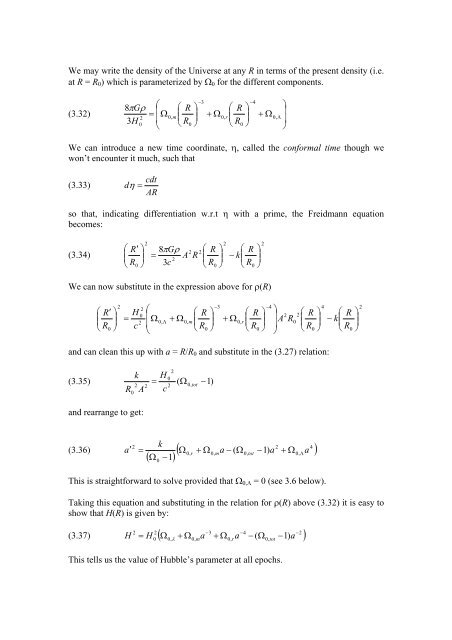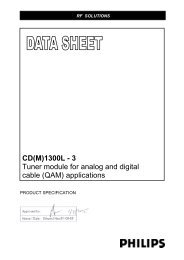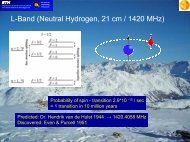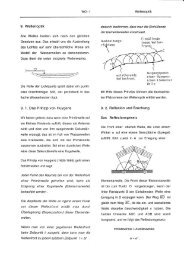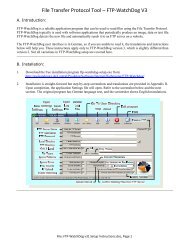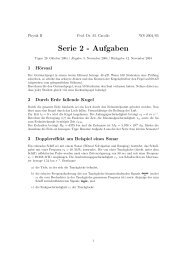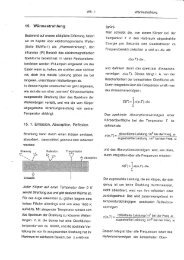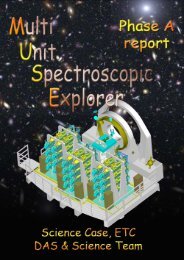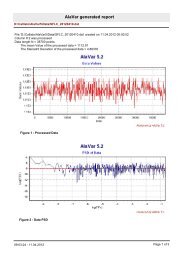Chapter 3: THE FRIEDMANN MODELS
Chapter 3: THE FRIEDMANN MODELS
Chapter 3: THE FRIEDMANN MODELS
Create successful ePaper yourself
Turn your PDF publications into a flip-book with our unique Google optimized e-Paper software.
We may write the density of the Universe at any R in terms of the present density (i.e.<br />
at R = R 0 ) which is parameterized by Ω 0 for the different components.<br />
(3.32)<br />
8πGρ<br />
3H<br />
2<br />
0<br />
⎛<br />
⎜Ω<br />
⎜<br />
⎝<br />
⎛ R ⎞<br />
⎜<br />
⎟<br />
⎝ R0<br />
⎠<br />
−3<br />
+ Ω<br />
⎛ R ⎞<br />
⎜<br />
⎟<br />
⎝ R0<br />
⎠<br />
−4<br />
+ Ω<br />
=<br />
0, m<br />
0, r<br />
0, Λ<br />
⎞<br />
⎟<br />
⎟<br />
⎠<br />
We can introduce a new time coordinate, η, called the conformal time though we<br />
won’t encounter it much, such that<br />
(3.33)<br />
cdt<br />
d η =<br />
AR<br />
so that, indicating differentiation w.r.t η with a prime, the Freidmann equation<br />
becomes:<br />
(3.34)<br />
⎛ R′<br />
⎞<br />
⎜<br />
⎟<br />
⎝ R ⎠<br />
2<br />
8πGρ<br />
2<br />
= A R<br />
2<br />
c<br />
0 3<br />
2<br />
⎛<br />
⎜<br />
⎝<br />
R<br />
R<br />
0<br />
⎞<br />
⎟<br />
⎠<br />
2<br />
⎛<br />
− k<br />
⎜<br />
⎝<br />
R<br />
R<br />
0<br />
⎞<br />
⎟<br />
⎠<br />
2<br />
We can now substitute in the expression above for ρ(R)<br />
⎛ R′<br />
⎞<br />
⎜<br />
⎟<br />
⎝ R0<br />
⎠<br />
2<br />
=<br />
H<br />
c<br />
2<br />
0<br />
2<br />
⎛<br />
⎜Ω<br />
⎜<br />
⎝<br />
0, Λ<br />
+ Ω<br />
0, m<br />
⎛<br />
⎜<br />
⎝<br />
R<br />
R<br />
0<br />
⎞<br />
⎟<br />
⎠<br />
−3<br />
+ Ω<br />
0, r<br />
⎛<br />
⎜<br />
⎝<br />
R<br />
R<br />
0<br />
⎞<br />
⎟<br />
⎠<br />
−4<br />
⎞<br />
⎟ 2<br />
A R<br />
⎟<br />
⎠<br />
2<br />
0<br />
⎛<br />
⎜<br />
⎝<br />
R<br />
R<br />
0<br />
⎞<br />
⎟<br />
⎠<br />
4<br />
⎛<br />
− k<br />
⎜<br />
⎝<br />
R<br />
R<br />
0<br />
⎞<br />
⎟<br />
⎠<br />
2<br />
and can clean this up with a = R/R 0 and substitute in the (3.27) relation:<br />
k H<br />
0<br />
(3.35) = ( Ω0,<br />
−1)<br />
2 2 2 tot<br />
R A c<br />
and rearrange to get:<br />
0<br />
2<br />
(3.36)<br />
a′<br />
2<br />
=<br />
k<br />
( ) ( 2<br />
4<br />
Ω<br />
)<br />
0, r<br />
+ Ω0,<br />
ma<br />
− ( Ω0,<br />
tot<br />
−1)<br />
a + Ω0,<br />
Λa<br />
Ω −1<br />
0<br />
This is straightforward to solve provided that Ω 0,Λ = 0 (see 3.6 below).<br />
Taking this equation and substituting in the relation for ρ(R) above (3.32) it is easy to<br />
show that H(R) is given by:<br />
2 2<br />
−3<br />
−4<br />
−2<br />
(3.37) H = H ( Ω + Ω a + Ω a − ( Ω −1)<br />
a )<br />
0<br />
0, λ<br />
0, m<br />
0, r<br />
0, tot<br />
This tells us the value of Hubble’s parameter at all epochs.


